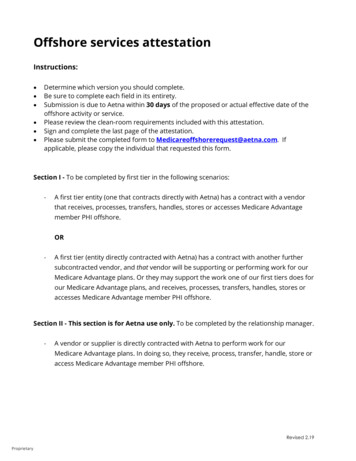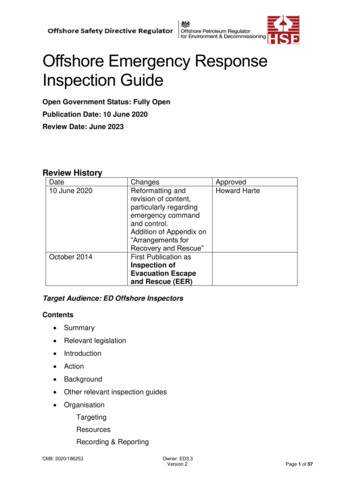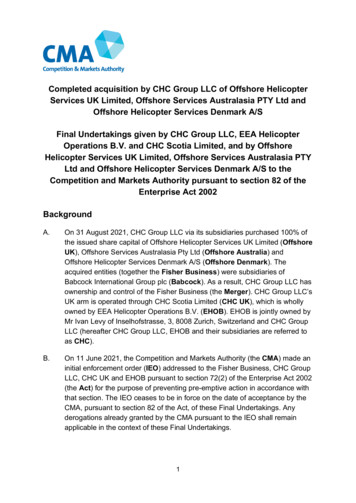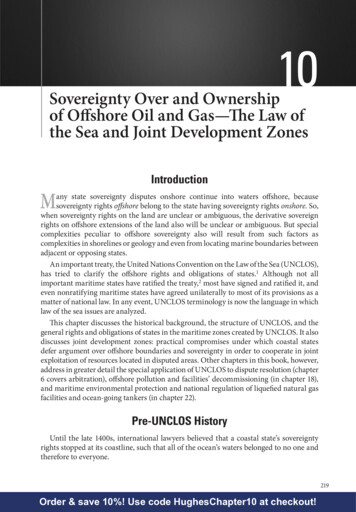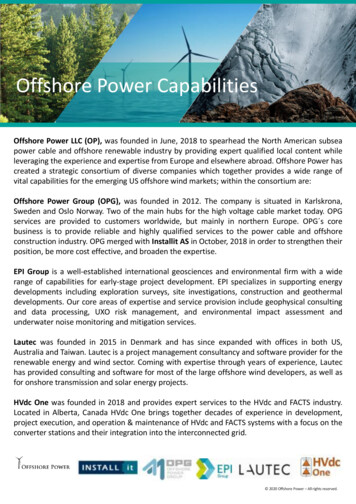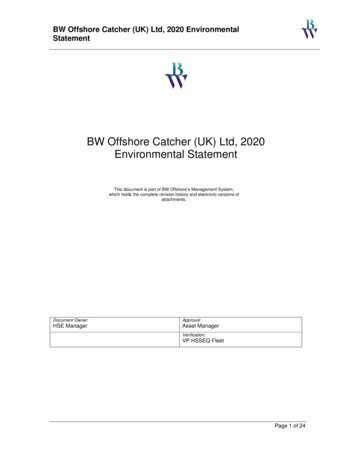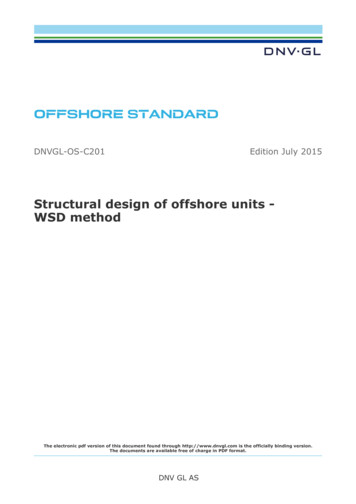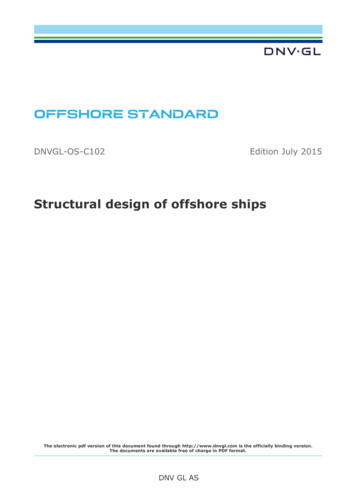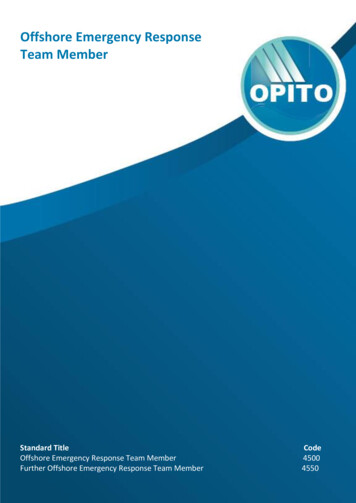
Transcription
Offshore Emergency ResponseTeam MemberStandard TitleOffshore Emergency Response Team MemberFurther Offshore Emergency Response Team MemberCode45004550
Offshore Emergency Response Team MemberOPITO STANDARDSOPITO is an Industry owned not for profit organisation that exists solely to service the needs of theOil and Gas Industry.OPITO is employer led in all aspects of what it does, therefore all standards development activitiesare at the behest of industry employers. The standards are driven by the needs of employers to helpcreate a safe and competent workforce.This standard is owned by the Oil and Gas Industry and maintained by OPITO who are the nominatedcustodians of all Industry standards within the OPITO portfolio which carry the OPITO logo.The contents of this document were developed by an industry workgroup facilitated and supportedby OPITO. The workgroup consisted of representation from a cross section of oil and gas Industryemployers, discipline experts working within the industry and members of the OPITO ApprovedTraining network.This standard has been verified and accepted through the governance and integrity managementmodel for OPITO standards.Guidance on this standard is available by contacting OPITO at: Standards enquiriesThis standard has been designed to accommodate global variations in national legislation andregulations. In the absence of relevant national legislation and regulations, OPITO approved centresmust use legislative and regulatory criteria specified within this Standard. OPITOAll rights reserved. No part of this publication may be reproduced, stored in a retrieval orinformation storage system, or transmitted in any form or my any means, mechanical,photocopying, recording or otherwise, without prior permission in writing of the publishers.Revision 5 Amendment 1 (January 2020)Page 2 of 44
Offshore Emergency Response Team MemberAmendmentsAmendment and Date1234Requirements for non-fireincident practice clarified –26/06/06Reconciledcompetencestatements for Element 3.2with the relevant assessor’schecklist – 17/09/07Changed to new OPITO logo;updated header, title page &numbering scheme gesChangesmade byChecked byApprovedby29, 31I. EmslieG. ClarkI. Emslie14, 22T. WilsonP. CrowtherT. WilsonAllT. WilsonP. CrowtherP. Crowther18, 37T. WilsonJ. CameronJ. Cameron5Moved revision bar to the Allheaderexcept09-12-08title pageT. WilsonJ. CameronJ. Cameron6Changed header to reflectamendmentnumberingscheme09-Dec 2008Replaced UKOOA with Oil &Gas UK: removed reference toCogent; added e-mail contact.7-Jun 2010Entire standard moved to newOPITO template10-Sept 2010Allexcepttitle pageT. WilsonJ. CameronM. DuncanAllL. GeddesM. CarrJ. CameronAllM. CarrP. LammimanJ. CameronChanged title: Further Live FireScenario Exercises to FurtherOffshore Emergency ResponseTeam Member & updatedAppendix 1.10-Jan 2013Revision 42013 three-yearly IndustryReview completedAug 2013Included more detailedguidance for practicalexercises concerning rescuingof casualty from elevatedwork area with restrictedaccess – Element 3.5.1(g) andElement 1.1 Practical ExercisesVariousM. CarrOPITOP. LammimanStandards Approvals&Melissa FooOPITOStandardsApprovalsOPITO& Standards &Development7891Revision 5 Amendment 1 (January 2020)19, 20,25P. LammimanPage 3 of 44
Offshore Emergency Response Team Member(g)2Revision 4 Amendment 111-Feb 2014Revised section A2 to statethat no formal pre requisitesexist. Amended the minimumdelegate ratio from 6delegates to 4Revision 4 Amendment 224-Nov 2016 A2 pg6Pg27 SARevision 52017 Industry Reviewreleased 4th February 2019Amendment 1 – January 2020– Removal of Appendix rDirector(Standardsand QA)Any amendments made to this standard will be recorded above.Revision 5 Amendment 1 (January 2020)Page 4 of 44
Offshore Emergency Response Team MemberCONTENTSIntroduction . 6OERTM Initial Training . 7A.1A.2A.3A.4A.5A.6A.7A.8OERTM INITIAL TRAINING TARGET GROUP . 7OERTM INITIAL TRAINING DELEGATE PRE-REQUISITES . 7OERTM INITIAL TRAINING PHYSICAL AND STRESSFUL DEMANDS . 8OERTM INITIAL TRAINING AIM AND OBJECTIVES. 8OERTM INITIAL TRAINING LEARNING OUTCOMES . 8OERTM INITIAL TRAINING DELEGATE PERFORMANCE ASSESSMENT. 9OERTM INITIAL TRAINING DURATION AND TIMING . 10OERTM INITIAL TRAINING PROGRAMME . 11OERTM Further Training . 20B.1B.2B.3B.4B.5B.6B.7B.8OERTM FURTHER TRAINING TARGET GROUP . 20OERTM FURTHER TRAINING DELEGATE PRE-REQUISITES . 20OERTM FURTHER TRAINING PHYSICAL AND STRESSFUL DEMANDS . 21OERTM FURTHER TRAINING AIMS AND OBJECTIVES . 22OERTM FURTHER TRAINING LEARNING OUTCOMES . 22OERTM FURTHER TRAINING DELEGATE PERFORMANCE ASSESSMENT . 22OERTM FURTHER TRAINING DURATION AND TIMING . 23OERTM FURTHER TRAINING PROGRAMME . 24Resources . 26C.1C.2C.3C.4STAFF . 26TRAINER/DELEGATE RATIO. 26FACILITIES. 27EQUIPMENT . 29Administration and Certification . 30D.1D.2D.3D.4JOINING INSTRUCTIONS . 30PERIODICITY. 30CERTIFICATION . 31COURSE ADMINISTRATION . 31OERTM Workplace Competence. 32E.1E.2E.3OERTM WORKPLACE COMPETENCE . 32OERTM WORKPLACE COMPETENCE UNITS . 33OERTM WORKPLACE ASSESSMENT . 42Glossary of Terms and Abbreviations . 43Revision 5 Amendment 1 (January 2020)Page 5 of 44
Offshore Emergency Response Team MemberIntroductionThis Offshore Emergency Response Team Member (OERTM) Training Standard has been developedby an Industry Work Group comprising representatives from key oil and gas industry stakeholdersincluding regulatory bodies, trade associations, Operator/Duty Holder organisations, drillingorganisations, contractor organisations, specialist assessment providers and OPITO-approvedTraining Providers.Training and competence assessment of OPITO-approved Offshore Emergency Response TeamMembers (OERTMs) will comprise both onshore training and offshore workplace training andassessment.Appointment of OERTMsThe Installation, MODU or vessel Duty Holder is responsible for ensuring that personnel appointed toOffshore Emergency Response Team Member (OERTM) role has received sufficient training andgained relevant experience to undertake the role(s) competently and safely.The Duty Holder must ensure that, apart from the provision of onshore training:a) Workplace training is provided and workplace competence assessment is conducted, ANDb) Additional Specialist Training - e.g. confined space or working at height (WAH) training(where required by duty holder) is provided before the OERTM is appointed to the role.OPITO-certified OERTM Training(1)The OERTM Initial Training – which will be conducted at an onshore training centreSection A).(see(2)The OERTM Further Training – this programme involves updating and refreshingrelevant knowledge and undertaking emergency response training not able to beconducted offshore (see Section B)Workplace Training and AssessmentIn addition to the onshore-based training, company and site-specific training and assessment willtypically be conducted offshore. This document also specifies the standard for the workplacecompetence requirement.OERTM emergency response training that can be conducted offshore will be conducted andrecorded on a regular basis during drills and exercises. Workplace OERTM Competence guidance forduty holders is specified in The OERTM Workplace Competence Units within Section E of thisstandard.Note: This Standard does not include practical training for accommodation fires involving ventilationfire in compartments where backdraft potential exists. Other specialist training exists in this areaand should be undertaken where deemed necessary.Revision 5 Amendment 1 (January 2020)Page 6 of 44
Offshore Emergency Response Team MemberOERTM Initial TrainingA.1OERTM Initial Training Target GroupThe target group for the OERTM Initial Training Programme is personnel who are appointed to, or tobe appointed to, the role of an Offshore Emergency Response Team Member.A.2OERTM Initial Training Delegate Pre-requisitesThere are no formal prerequisites for the OERTM training programme.Revision 5 Amendment 1 (January 2020)Page 7 of 44
Offshore Emergency Response Team MemberA.3OERTM Initial Training Physical and Stressful DemandsTraining and/or assessment activities contained within this Standard may include physicallydemanding and potentially stressful elements. All personnel who participate in such activities mustbe capable of participating fully.Delegates require some form of medical and/or fitness screening to ascertain that they are fit toundertake this type of training.Therefore OPITO-approved training centres are required, as a minimum, to ensure that prior toparticipating in practical exercises, the delegate must:a) Possess a valid, current offshore medical certificate orb) Possess an operator approved medical certificate, orc) Undergo medical screening by completing an appropriate medical screening form providedby the OPITO-approved centre (a list of medical conditions which could be included in amedical screening form is available from OPITO).The OPITO-approved Centre shall keep a record of the delegate’s/candidate’s declaration of fitnessin accordance with their document control policy(s) or procedures.This information, along with summary details of the type of physical activities thedelegate/candidate will be asked to perform, will be given to delegates/candidates by the OPITOapproved Centre and, if applicable, to their sponsoring company as part of the joining instructions.The responsibility for declaring any current or pre-existing medical conditions that could haveadverse effects to the individual’s state of health while undertaking the training and/or assessmentactivities lies with the delegate/candidate and/or company sponsoring the delegate.Where doubt exists regarding the fitness of any delegate/candidate, the OPITO-approved Centreshould direct the individual to consult a medical officer familiar with the nature and extent of thetraining.Note: Practical exercises should be designed and delivered solely to meet this standard, and mustnot place on the delegates any demands other than those required to meet the Standard.A.4OERTM Initial Training Aim and ObjectivesThe aim and objectives of the OERTM Initial Training Programme are to equip the delegate with thenecessary knowledge, understanding and skills to perform the role of Offshore Emergency ResponseTeam Member effectively.A.5OERTM Initial Training Learning OutcomesThe delegate’s learning outcomes are set out below.Revision 5 Amendment 1 (January 2020)Page 8 of 44
Offshore Emergency Response Team MemberDelegate must be able to know and understand:(1)(2)(3)(4)(5)(6)(7)(8)The role and key responsibilities of the Offshore Emergency Response Team Member (OERTM)Factors which may affect the safety of the OER team and individual team membersTypical communication hierarchy and processes used during an incidentTypical communication methods and their limitationsTypical offshore emergency response arrangementsHazards, hazard recognition and mitigation associated with typical fire and non-fire incidentsThe key elements of incident planning and progress monitoringThe purpose, operation, performance and limitations of typical fixed fire-fighting systems usedoffshore(9) Typical OER team mobilisation procedures(10) The key elements included in an incident briefDelegate must be able to demonstrate:(11) How to select and operate the correct firefighting equipment and media to extinguishdifferent types of fires(12) Breathing apparatus control board procedures(13) How to identify and don the appropriate emergency response PPE required for the OER teammember(14) The operation, donning and wearer checks of working duration breathing apparatus(15) Participation in an incident brief(16) Participation as an OER team member in a specified range of fire and non-fire relatedincidents under the direction of the Offshore Emergency Response Team Leader (OERTL)following safe working practices and procedures(17) Selection and use of correct portable fire-fighting equipment(18) Selection, operation and flushing of foam firefighting equipment(19) Extinguishing of different types of fire and securing the area(20) Effective communication with OERTL and OER team members during an incident(21) The key considerations and actions whilst entering and working in the incident area(22) Correct search and rescue procedures and techniques(23) The correct steps involved in initial casualty assessment and recovery(24) Participation in a post-incident debriefLearning Outcomes (11) through (24) are to be assessed during practical exercises.A.6OERTM Initial Training Delegate Performance AssessmentDelegates attending this training and assessment programme will be given a series of explanationsand demonstrations which will identify what they are expected to know and do in their role asOffshore Emergency Response Team Member (OERTM). This will be followed by practical exercisesRevision 5 Amendment 1 (January 2020)Page 9 of 44
Offshore Emergency Response Team Memberwhich will allow delegates to demonstrate their skills, knowledge and understanding of theiremergency response role.Delegates will be assessed against the knowledge learning outcomes 1 through 10 (specified inSection A.5) by written, open-book test or series of tests. The written tests must incorporate abalanced mix of the following question types:(a) Multiple choice(b) True/False(c) A small number of questions that require written answers.Delegates will be assessed against the practical learning outcomes 11 through 24 (specified inSection A.5) using direct observation and oral questions as appropriate.If required, further time and opportunity for coaching will be given to delegates to enable them toattain the standard leading to the award of a certificate. However, the time available for this duringa programme is limited and it must be recognised there may be occasions where otherarrangements need to be made.A.7OERTM Initial Training Duration and TimingThe optimum *contact time for this OPITO programme is 32 hours, which is to be delivered overconsecutive days. An approximate ratio of 25% theory to 75% practical is appropriate for thistraining programme.The contact time is based on the maximum number of delegates/candidates undertaking theprogramme.Individual module/unit/element timings that are specified within the standard must be adhered to.The contact time must not exceed 8 hours in any one day and the **total programme day must notexceed 10 hours.Practical and theory sessions must contain adequate breaks for delegate welfare.*Contact time includes the delivery of the theoretical and practical training/assessment programme.**The total programme day includes the delegate enrolment and certification process, contacttime, welfare breaks, meal breaks and where applicable, travel between sites.Revision 5 Amendment 1 (January 2020)Page 10 of 44
Offshore Emergency Response Team MemberA.8OERTM Initial Training ProgrammeThe OERTM Initial Training Programme specified below will assist the delegates to meet the learningoutcomes specified in Section A.5. The order in which elements of the training programme aredelivered may vary.To make efficient use of time and ensure effective learning there must, wherever practicable, be anintegration of the three phases of explanation, demonstration and practice. Full use must be madeof visual/audio aids and course handout material. Training staff must give practical demonstrationsfor all training activities which delegates are required to practise and demonstrate.Each module must be introduced prior to commencing the session and must include:(a)(b)(c)(d)AimLearning OutcomesTimetable/ProgrammeAssessment(e) StaffThe main purpose of the moduleWhat the delegates are expected to learnTraining module duration and timingsHow delegates will be assessed and what they will beassessed againstWho will be delivering the training and roles of trainingsupport staffThe OERTM Initial Training Programme comprises the following modules and elements:Module 1Element 1.1Element 1.2The Role of the Offshore Emergency Response Team MemberTeamwork and CommunicationsOffshore Emergency Response ArrangementsModule 2Element 2.1Element 2.2Element 2.3Element 2.4Element 2.5Incident ResponseSelection and Operation of Firefighting EquipmentWorking Duration Breathing ApparatusIncident ResponseSearch and RescueCasualty RecoveryModule 3Element 3.1Practical Exercises for the OERTMPractical Fire and Non-Fire Related IncidentsRevision 5 Amendment 1 (January 2020)Page 11 of 44
Offshore Emergency Response Team MemberMODULE 1The Role of the Offshore Emergency Response Team MemberELEMENT 1.1Teamwork and CommunicationsTraining staff to explain:1.1.1The elements of teamwork and their application to offshore emergencyresponse teams, to include:(a)(b)(c)(d)1.1.2The role and key responsibilities of the OERTMThe role and key responsibilities of the OERTL, including subleadershipMaintaining the safety of the OER teamHuman factors that may affect the safety of the OER team andindividual team membersThe elements of effective communication, to include:(a)Typical communication hierarchy and processes during an incident(b)Various communication methods and their limitations, including:i.ii.iii.iv.v.(c)runnershand signalsradiostelephonevocal.Control requirements to include designated ER radio channelsRevision 5 Amendment 1 (January 2020)Page 12 of 44
Offshore Emergency Response Team MemberELEMENT 1.2Offshore Emergency Response ArrangementsTraining staff to explain:1.2.1Typical offshore emergency response arrangements, to include:(a)(b)(c)(d)(e)(f)(g)(h)1.2.2Key legislation relevant to OERTM role in region of operationsEmergency Alarms and ProceduresEmergency and incident planning including hazard recognitionLevels of emergency and response to include: preparedness,response actions, and recoveryEmergency management roles (individual and team roles)Incident control centresEmergency communication protocols.Importance of familiarisation with company/asset specificemergency response arrangementsHazards, hazard recognition and mitigation associated with typical fire and nonfire incidents, to include:Fire:(a)(b)(c)(d)(e)(f)(g)(h)Rotating machineryElectricalPressure-fedChemical including methanol and oxidising agentsExplosivesAccommodation, galley and laundryFire behaviour in relation to backdraft and flashoverHazardous areas including processing, drill floor/well test area andfabrication nited gas releasesunignited fuel spillageschemical spillradiation incidenttoxic gas release and asphyxiatesCryogenic release (i.e. LNG)electrical incidentconfined space incidentworking at height incidentmedical emergencyERT involvement with the Heli-deck TeamRevision 5 Amendment 1 (January 2020)Page 13 of 44
Offshore Emergency Response Team Member1.2.3Incident planning and progress monitoring, to include:(a)(b)(c)(d)(e)(f)1.2.4Typical Safety Case/ER plansThe various stages of emergency responseKey emergency assessment points including dynamic risk assessmentand 360 degree assessmentEstablishing the layout of the incident area and boundariesAccess and egress planningLocation of fire and emergency equipment.The purpose, operation, performance and limitations of typical fixed fire-fightingsystems offshore, including:Active Systems:(a)(b)(c)(d)(e)(f)(g)(h)fire pumpsdelugessprinklersmonitorsfoamgaseous systemswater mistchemicalPassive Systems:(i)(j)(k)1.2.5blast and fire wallspassive fire protectionbulk heads/compartmentationER team familiarisation of significant changes to structural layout ofinstallation/vessel e.g. during commissioning or decommissioning.Revision 5 Amendment 1 (January 2020)Page 14 of 44
Offshore Emergency Response Team MemberMODULE 2Incident ResponseELEMENT 2.1Selection and operation of firefighting equipmentTraining staff to explain and demonstrate, and delegates to practise:2.1.1Selection and operation of firefighting equipment and media to extinguish fires.Training Instructors to explain the suitability, limitations of the variousfirefighting equipment and media stated below.Fire types:(a)(i)(ii)(iii)Responding to, and extinguishing the following common fire types:Class A (solids)Class B (hydrocarbon liquids) (spill, flowing and pressure-fed)Class C (gases).(b)(i)(ii)(iii)(iv)Using portable fire equipment, to include:dry chemical extinguishershose reels,hose branchesmonitors(c)(i)(ii)(iii)(iv)Using foam equipment , to include :inductorsbranchescompound containersflushing after use.(d)(i)(ii)(iii)(iv)(v)Hose operations, to include:running out and under-runningconnecting to ancillary equipmentrouting through: walkways, stairways and inside modulesadding and replacing lengths of hosesmaking up following use of hoses.(e)(i)(ii)(iii)(iv)Using the following firefighting media:water*foamCO2dry chemicalEquipment:Media:*foam - types of concentrate, application techniques and post fire security.Revision 5 Amendment 1 (January 2020)Page 15 of 44
Offshore Emergency Response Team MemberELEMENT 2.2Working Duration Breathing ApparatusTraining staff to explain and demonstrate, and delegates to practise:2.2.1Breathing apparatus control board procedures, to include:(a)(b)(c)2.2.2Setting up the BA control board in a safe locationCalculation of working durations and whistle timesUsing BA control board tally procedures.Operation, donning and wearer checks of working duration breathingapparatus*, to include:(a)(b)(c)(d)(e)(f)(g)(h)Pre-operational checksWearer checks, to include face sealDonningOperationWhistle checkMonitoring usage in the incident area – gauge checksCylinder handlingRecording requirements*Note: Training Staff must explain that there are a variety of BA types used in industry and thatdelegates must familiarise themselves with the specific type(s) used at their workplace.ELEMENT 2.3Incident ResponseTraining staff to explain:2.3.1Typical OER team mobilisation proceduresTraining staff to explain and demonstrate:2.3.2Key elements in incident brief, on and type of incidentPurpose and objectives of entrySafe access and egressProcess conditions and associated local hazardsActive work sitesPeople in areaFire protection and detection systems in operationPotential effects of incident on infrastructure (ie. FRP grating)Weather conditions including prevailing windCommunication processesIncident withdrawal arrangementsTypes and donning of PPE for different incidents i.e. chemical andfirefighting PPERevision 5 Amendment 1 (January 2020)Page 16 of 44
Offshore Emergency Response Team MemberTraining staff to explain:2.3.3Considerations and actions whilst entering and working in the incident area, toinclude:(a)Dynamic risk assessment, including but not limited to:(i) team safety considerations(ii) discovering casualties(iii) effects of the incident on the area(iv) maintaining access and egress(b)Movement through the incident area, to include:(i)(ii)(iii)(iv)(c)(d)Door entry proceduresupright (BA shuffle)crawldescend/ascend stairs and laddersEffective communicationsHuman behaviours during emergency response, including:(i) effects of heat and humidity(ii) stress affecting decision making(ii) loss of orientation/location(iv) Physical limitations(v) Sources of assistance available during emergency2.3.4Incident conclusion including:(a)(b)(c)(d)Making the area safePreparation for next incident responsePost incident debriefPotential investigation requirementsRevision 5 Amendment 1 (January 2020)Page 17 of 44
Offshore Emergency Response Team MemberELEMENT 2.4Search and RescueTraining staff to explain:2.4.1Typical search and rescue procedures, equipment and techniques, involving ion and module design, to include:open/closed modulesdiffering ng ladders and stairsMethods of access and egressMaintenance of means of escapeVarying range of visibility, to include one of each of the followingsearch and rescue scenarios:(i) Without BA and no smoke(ii) With BA and no smoke(iii) With BA and smokeELEMENT 2.5Casualty RecoveryTraining staff to explain and demonstrate:2.5.1Casualty recovery, to include:(a)(b)(c)(d)(e)Initial casualty assessment and recoveryImportance of getting the casualty to a safe area for furtherassessmentSituations where essential first aid might be carried out by OERTMSources of available specialist first aid supportCasualty handling equipment (i.e. stretchers, harnesses, slings)Revision 5 Amendment 1 (January 2020)Page 18 of 44
Offshore Emergency Response Team MemberMODULE 3Practical Exercises for the OERTMElement 3.1Practical Fire and Non-Fire Related IncidentsDelegates to practice and demonstrate (by participating in practical exercises* as part of a teamcovering a range of fire and non-fire related incidents under the direction of an .93.1.103.1.113.1.123.1.13How to select and operate the correct firefighting equipment and media toextinguish different types of firesBreathing apparatus control board proceduresHow to identify and don the appropriate emergency response PPE required for theOER team memberThe operation, donning and wearer checks of working duration breathing apparatusParticipation in an incident briefSelection and use of correct portable fire-fighting equipmentSelection, operation and flushing of foam firefighting equipmentExtinguishing of different types of fires and securing the areaEffective communication with OERTL and OER team members during an incidentThe key considerations and actions whilst entering and working in the incident areaCorrect search and rescue procedures and techniquesThe correct steps involved in initial casualty assessment and recoveryParticipation in a post-incident debrief and ensure operational readiness*Practical exercises used must include appropriate combinations of all of the following scenarios:Fire-related Incidents:(a)(b)(c)(d)(e)Accommodation (multi-level) including galley or laundry firesProcess area (open and closed) including internal and external highpressure and pool firesMachinery space including engine room/plant roomFabrication area including workshop/paint storeClosed containers or cylinders exposed to fire.Non fire related incidents:(f)(g)(h)(i)Unignited gas and liquid releasesChemical incidentConfined space incidentWorking at height incident with restricted accessNotes for i)(1)(2)(3)(4)Height must be a minimum of 2 metres and a maximum of 4 metresBasic rescue exercise without specialist support involving non-suspended casualty.Restricted access would involve the use of equipment such as ladder, access hatch,stretcher.Elevated work area examples include scaffolding, crane operator cabin, elevatedmaintenance area etc.Revision 5 Amendment 1 (January 2020)Page 19 of 44
Offshore Emergency Response Team Membe
incident practice clarified - 26/06/06 29, 31 I. Emslie G. Clark I. Emslie 2 Reconciled competence statements for Element 3.2 with the relevant assessor's checklist - 17/09/07 . OERTM emergency response training that can be conducted offshore will be conducted and recorded on a regular basis during drills and exercises. .
